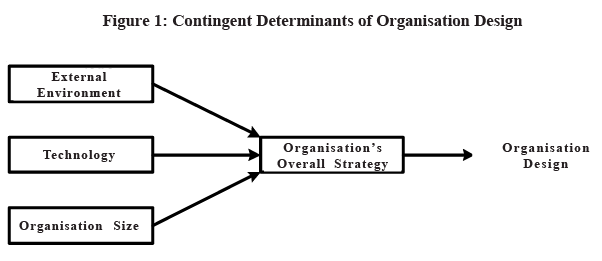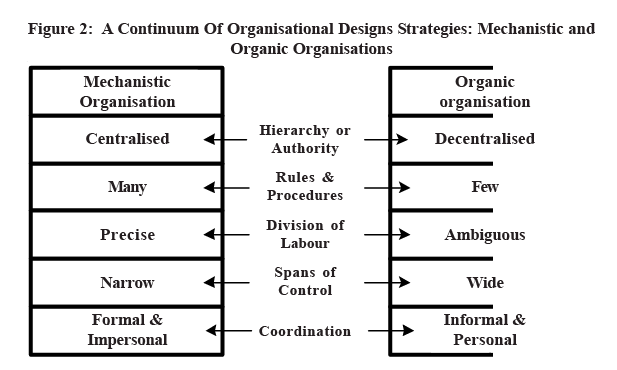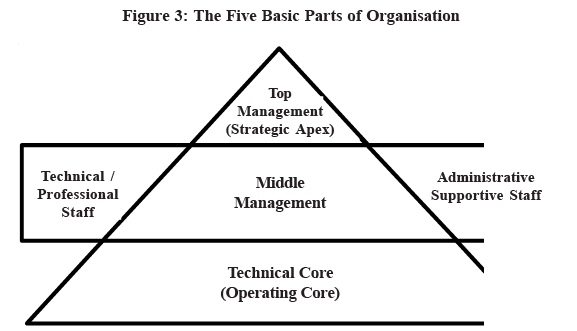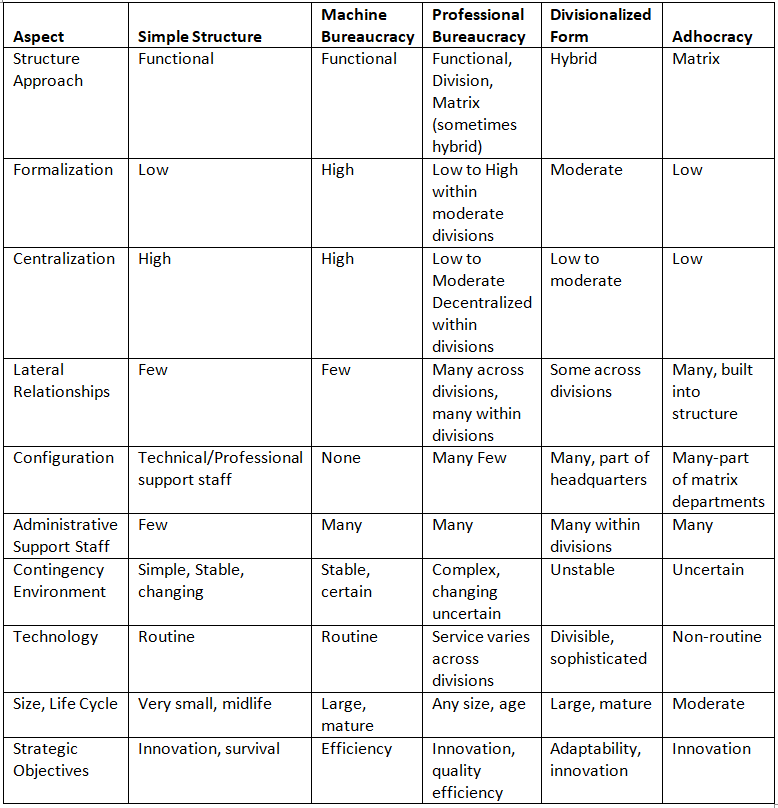Introduction
The field of organizational design lacks a fully developed set of theoretical principles and established practices that can effectively address the diverse needs of various organizations, as noted by Lomash and Mishra in 2003. Nevertheless, there exist three overarching perspectives on organizational design: 1) the bureaucratic model; 2) the behavioral model; and 3) the contingency perspective.
The Bureaucratic Model
German sociologist Max Weber introduced the concept of bureaucracy, emphasizing its significance in organizational design. Weber's perspective defined bureaucracy as an organization built upon a legitimate and formal system of authority.
According to Weber, an ideal organization should possess the following characteristics:
- Division of labor based on functional specialization.
- A clear hierarchy of authority, ensuring a well-defined chain of command from the top to the bottom of the organization.
- A system of rules outlining the rights and duties of employees.
- Established procedures for addressing work situations.
- Promotion and selection based on technical competence.
- Impersonal interpersonal relations, where managers maintain an appropriate social distance from subordinates.
Despite being the foundational model for understanding and applying organizational design, the Weberian approach has notable drawbacks. It tends to become overly focused on rules and regulations, potentially losing sight of the organization's actual objectives. Additionally, this model is ill-suited for dynamic and uncertain external environments, as bureaucratic structures may become too rigid to adapt quickly to external changes.
The primary strength of this model lies in its historical significance as the initial organizational design framework, forming the fundamental basis for comprehending and implementing more recent approaches. However, notable drawbacks include:
- The model often becomes entangled in an excess of rules and regulations, potentially leading to a loss of focus on the organization's actual objectives.
- It is not well-adapted to dynamic and uncertain external environments. Bureaucratic structures may become overly rigid and formalized, hindering organizations from adapting quickly to external changes.
The Behavioural Model
- This model has originated from the Human Relations School of management thought. Unlike the classical bureaucratic model, which considers individuals as part of a group without individual identification, the behavioral model emphasizes that an organization's performance is influenced by human beings, their behavior, characteristics, and interpersonal relationships emerging from work patterns and organizational settings.
- Crucial factors in this model include needs, motivations, attitudes, values, leadership, group behavior, perceptions, communications, and the dynamics of responsibility and authority relationships (Lomash and Mishra, 2003). In essence, behavioral models of organizational design focus on the social and psychological aspects of organizational life. Two prominent behavioral models, the socio-technical systems theory and Likert’s System 4 Organization, are briefly outlined here.
Socio-technical Systems Theory
- The socio-technical systems theory, developed by Eric Trist and K.W. Bamforth in their examination of alternative coalmining methods, and by A.K. Rice and colleagues at England’s Tavistock Institute, aims to strike a balance between an organization's human and technical aspects. This theory focuses on two interrelated systems: (1) a social system that encompasses all human interactions sustaining both formal and informal organizations, and (2) a technical system that outlines the tasks involved in producing an organization's goods and services.
- For instance, in the production of aluminum, the technical system includes machinery and operations such as ore crushing, grinding (Bauxite), desanding, desilication, settling, washing, filtration, precipitation, classification, and alumina conversion into aluminum metal. Simultaneously, the social system operating this equipment involves individuals and groups whose interests, ideas, creativity, motivation, and needs require attention. Therefore, the socio-technical model asserts that effective management necessitates equal consideration of both the technical and social systems within the organization to ensure its efficient and effective functioning.
Question for Modern Concepts of Organisation Theory: Organisational Design
Try yourself:
Which model of organizational design emphasizes the social and psychological aspects of organizational life?Explanation
- The behavioral model of organizational design focuses on the social and psychological aspects of organizational life.
- It emphasizes that an organization's performance is influenced by human beings, their behavior, characteristics, and interpersonal relationships.
- This model recognizes the importance of needs, motivations, attitudes, values, leadership, group behavior, perceptions, communications, and the dynamics of responsibility and authority relationships.
- Unlike the bureaucratic model, which is more focused on formal systems and rules, the behavioral model highlights the significance of individuals and their interactions within the organization.
- By considering the social and psychological factors, the behavioral model aims to improve organizational performance and effectiveness.
Report a problem
Likert’s System 4 Organisation
- Rensis Likert, a social scientist affiliated with Michigan's Institute for Social Research, identified a crucial connection between organizational design and effectiveness. His research focused on eight organizational characteristics: leadership, motivation, communication, interaction, decision-making, goal-setting, control, and performance goals.
- Likert observed that organizations tend to embody these characteristics through four approaches, termed Systems 1, 2, 3, and 4. Systems 1 and 4 have notably contributed to organizational design theory. Likert's System 1 represents a bureaucratic organizational design, characterized by downward information flow, a centralized decision process with distortion, top-down goal-setting, centralized control, and discouragement of group participation. Conversely, System 4 represents a behavioral organizational design, featuring free and undistorted information flow, decentralized decision-making, group participation encouraged in goal-setting, dispersed control emphasizing self-control and problem-solving.
- Based on his studies, Likert advocated for organizations to adopt the System 4 approach to organizational design. A key strength of System 4 lies in its recognition of the unique value of each organizational member, in contrast to the impersonal treatment seen in the bureaucratic model. However, a notable weakness of the System 4 approach is its premise that there is a singular "best way" to design organizations. It is widely acknowledged that organizational design effectiveness depends on various contingency factors, challenging the notion of a universally optimal approach (Burton and Thakur, 1995).
The Contingency Perspective
- The contingency perspective on organization design is based on the idea that the optimal design for any organization depends on various situational factors.
The key situational or contingency factors include:- External environment
- Technology
- Organization size
- Organizations can be classified as open systems or closed systems. Open systems have permeable boundaries and engage in constant interaction with their external environment, allowing them to influence and be influenced by external activities. Closed systems, on the other hand, operate independently and have no transactions with the external environment, being self-contained. For the purpose of our discussion, we assume that modern organizations are open systems, actively interacting with their environments.
- Given that an organization's objectives are derived from its overall strategy, there is a natural connection between an organization's design and its strategy. Consequently, if management decides to make a significant change in strategy, the organization's design must be adjusted to accommodate and support that change. Empirical evidence strongly suggests that the selection of an organization's strategy is influenced by the contingency factors outlined, as depicted in Figure 1.

- An organization's strategy outlines its goals and the methods it intends to employ to achieve those goals. Changes in an organization's external environment may necessitate adjustments to its strategy.
- Empirical research strongly supports the idea that "structure follows strategy." The strategic planning process of an organization serves as a mediator between the external environment, the organization's design, and the technical processes involved in producing its products or services. For instance, in response to uncertainties in a product's market (external environment), the strategic planning process can enhance innovation related to that product. Successfully implementing such product innovation may require modifications to the organization's design and/or technical processes.
External Environment
- Every organization is situated within the broader context of the 'general environment' and the 'task environment.' The general environment encompasses economic, technical, sociocultural, political, legal, and international dimensions that influence the organization and its task environment. Meanwhile, the task environment includes customers, competitors, suppliers, and government agencies.
- Burns and Stalker (1961) conducted research in England, revealing the connections between organization design and the environment. They identified two contrasting types of environments: (1) a stable environment, which remains relatively constant over time, and (2) an unstable environment, characterized by change and uncertainty. Examining organizations in these environments, they found that those in stable environments tended to have a different structure than those in unstable environments. Burns and Stalker termed these organizations with different structures as mechanistic and organic.
- A mechanistic organization, akin to Max Weber's bureaucratic organization or Likert’s System 1 organization, is typically found in stable environments. It is characterized by rules, regulations, standardized procedures, and centralized decision-making.
- On the other hand, an organic organization, resembling the behavioral model and Likert’s System 4 organization, is commonly found in unstable environments. Adaptation to frequent environmental changes leads organic organizations to embrace flexibility, non-routine methods, a limited number of rules and regulations (often unwritten), decentralized authority, and the creation of autonomous work teams.
- Figure 2 illustrates the distinct characteristics of organic and mechanistic organizations. The work of Burns and Stalker was later expanded by Harvard Business School researchers Paul Laurence and J. Lorsch. Their research indicated that in more uncertain environments, organizations require specific coordination mechanisms such as liaison managers, task forces, and teams.
Technology
- Technology refers to the process through which an organization transforms inputs such as people, materials, equipment, money, and facilities. This process can be mechanical, as seen in manufacturing organizations, or involve providing services to clients, as in banks, hospitals, or insurance companies. It can also be predominantly mental, found in organizations that solve problems or generate new ideas, products, and services, such as research and development organizations, advertising agencies, and software development firms.

- Research on the relationship between technology and organizational design has generated significant controversy. While studies by Joan Woodward, James Thompson, Charles Perrow, and Howard Aldrich support technology as a contingency factor in organization design, other studies disagree. For instance, the Aston Group's study in Birmingham, England concluded that organization size was a more critical determinant of structure than technology.
- Based on studies supporting the link between technology and design, the following conclusions have been drawn:
- Unit and process technologies align well with smaller spans of control and an organic structure, while mass production technology is suited for wider spans of control and a bureaucratic structure.
- Routine technologies are associated with a bureaucratic structure involving centralized decision-making and formal written rules and procedures.
- Organizations employing complex non-routine technologies tend to have more departments, fewer levels of authority, and more participative decision-making, making an organic structure more appropriate.
- New Information Technology fosters reciprocal interdependency within an organization, thriving in an organic structure rather than a bureaucratic one.
- Research indicates that large organizations exhibit different structural features than small organizations. Small organizations typically have minimal specialization, few formal rules and procedures, narrow spans of control, an informal decision process, and a simple design. In contrast, large organizations tend to feature extensive specialization, numerous formal written rules and procedures, more formalized relationships, and a decentralized structure.
Mintzberg’s Typology
- Henry Mintzberg's typology for integrating organization structure with contingency factors offers a clear understanding of the relationship between an organization's business strategy and its design.
- Mintzberg posited that every organization comprises five fundamental parts, as depicted in Figure 3. At the very top of each organization is the top management, also known as the 'strategic apex.' In the intermediate level lies the middle management. At the bottom is the technical core, also referred to as the 'operating core.' These three parts are illustrated in a sequence, indicating a single line of hierarchical authority. Essentially, the line function represents the chain of command running from top management to the technical core.

- The technical and professional staff personnel are positioned to the left of the middle line. These individuals, including engineers, researchers, and systems analysts, play a role in creating plans and controls that are applied to the technical core. On the right side of the middle line, administrative staff carries out indirect services such as maintenance, accounting, and clerical tasks. Mintzberg suggests that the relative size of each of these parts is determined by the organization's contingency factors.
- Mintzberg further proposed that these five organizational parts combine to form five basic structures: (1) simple structure, (2) machine bureaucracy, (3) professional bureaucracy, (4) divisionalized form, and (5) adhocracy. Table 1 provides details of the main features of these five organizational forms.
Question for Modern Concepts of Organisation Theory: Organisational Design
Try yourself:
What is Likert's System 4 approach to organizational design?Explanation
- Likert's System 4 approach to organizational design is a behavioral organizational design.
- It is characterized by decentralized decision-making and encouraged group participation.
- This approach emphasizes free and undistorted information flow, self-control, and problem-solving.
- It recognizes the unique value of each organizational member and promotes a flexible and adaptable structure.
Report a problem
Simple Structure
This form of structure is characteristic of a small and entrepreneurial firm. It involves a top manager and only a few workers (assistants) engaged in overlapping activities. In this structure, there may be a very small administrative staff, and the technical/professional staff is virtually absent. Key features include centralized decision-making, informal coordination, and minimal division of labor. Organizations utilizing service technology or small batch processing technology often adopt this structure. It is well-suited to adapt to the environment, with its goals emphasizing survival and innovation.

Machine Bureaucracy
- The machine bureaucracy is typically observed in large companies organized along functional lines with limited lateral coordination. Key features include adherence to bureaucratic principles, heavy specialization, a plethora of rules and regulations, centralized authority, a sizable technical/professional and administrative staff, and formalized processes.
- This form of structure is adopted by organizations involved in routine services or mass production technology. The environment of organizations using this structure is generally stable, and the primary goal is to enhance internal efficiency.
Professional Bureaucracy
- Professional bureaucracy is commonly found in large, functionally designed organizations that employ professional individuals. These organizations engage in non-routine service technology, where new problems arise regularly, task variety is high, and employees rely on experience, education, training, and trial and error in the search for alternative procedures, as there are no predefined procedures for encountered problems.
- Hospitals and universities serve as notable examples. Despite being highly formalized, these organizations decentralize decision-making authority to professionals actively involved in non-routine services. Organizations with this structure operate in complex and relatively stable environments, with goals focused on innovation and quality. Since professional staff handles core tasks, the technical staff tends to be small, while there is usually a large administrative staff.
Divisionalized Form
- The divisionalized form of organization is typically observed in large organizations with various subunits (divisions), such as product or market subunits. These units have few lateral coordinating devices and receive liaison services from corporate-level personnel. Decision-making is decentralized, with each division operating fairly autonomously.
- The units/divisions may employ different non-routine manufacturing technologies. The external environment of the organization tends to be stable. Technical staff is concentrated at corporate headquarters, providing services for all subunits/divisions, while administrative support is available within each division.
Adhocracy
- Adhocracy, akin to a matrix organization, emerges in complex environments where sophisticated technology is utilized. The structure of the organization is informal, featuring a dual chain of command for coordinating various activities.
- Notably, the administrative staff is large, while the technical support staff is relatively small, as most technical work is performed by experts located in the technical core.
Question for Modern Concepts of Organisation Theory: Organisational Design
Try yourself:
In which type of organizational structure is decision-making centralized and there is minimal division of labor?Explanation
- The simple structure is characterized by centralized decision-making and minimal division of labor.
- This structure is commonly found in small and entrepreneurial firms.
- It involves a top manager and a few workers engaged in overlapping activities.
- Key features include informal coordination and a small administrative staff.
- This structure is well-suited for organizations utilizing service technology or small batch processing technology.
- The primary goals of organizations with a simple structure are survival and innovation.
Report a problem





























